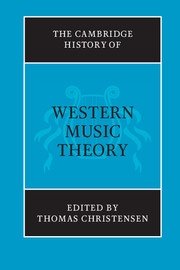Book contents
3 - Epistemologies of music theory
from PART I - DISCIPLINING MUSIC THEORY
Published online by Cambridge University Press: 28 March 2008
Summary
“The epistemological underpinnings of Schenker’s theory,” writes Leslie Blasius, “are far from obvious.” Such a statement might well give his readers pause. After all, Blasius is talking about what must be the most widespread approach to the advanced analysis of the common-practice repertory today, and the doubt he is expressing goes to the heart of what Schenkerian analysis tells us: what sort of knowledge of music it gives us, what sort of truth it aspires to. And this of a theorist who devoted considerable attention to the underpinnings of his theory, for instance by carefully distinguishing those elements of music that he saw as given in nature from those that resulted from artifice, and thereby demarcating the province of the scientist from that of the music theorist. Most music-theoretical writing betrays few of Schenker’s epistemological qualms; Allen Forte’s The Structure of Atonal Music, to cite an example more or less at random, plunges straight into its topic in the same spirit of epistemological self-evidence that characterized the contemporary scientific writing on which Forte modeled both his literary and his theoretical approach. Like scientists, perhaps, music theorists address epistemological issues only when the truth-value of their work no longer seems self-evident to them. And if this is the case – if music-theoretical concern with epistemology is at root an expression of anxiety – then we have a fundamental problem in trying to unravel the epistemological underpinnings of music theory: when theorists are confident of the epistemological status of their work they will say nothing about it, whereas when they do talk about it we can deduce they are not quite sure about what they are saying.
- Type
- Chapter
- Information
- The Cambridge History of Western Music Theory , pp. 78 - 106Publisher: Cambridge University PressPrint publication year: 2002
References
- 49
- Cited by



